Primary Health Promotion Against Diabetes in Australia Report
VerifiedAdded on 2022/08/20
|9
|1644
|9
Report
AI Summary
This report provides a comprehensive overview of primary health promotion strategies against diabetes in Australia. It begins by establishing the prevalence and incidence of diabetes within the Australian population, highlighting the significance of Type 2 diabetes and identifying key target audiences and risk factors, including obesity and lifestyle choices. The report then examines the Australian National Diabetes Strategy and its alignment with the Ottawa Charter for Health Promotion, emphasizing strategies such as building healthy public policy, reorienting health services, and strengthening community action. The role of NMBA codes and standards in guiding nursing interventions is discussed, along with specific nursing interventions for treating diabetes, including patient education, self-care management, and the promotion of healthy lifestyles. References to relevant studies and publications are included to support the findings and recommendations presented in the report.
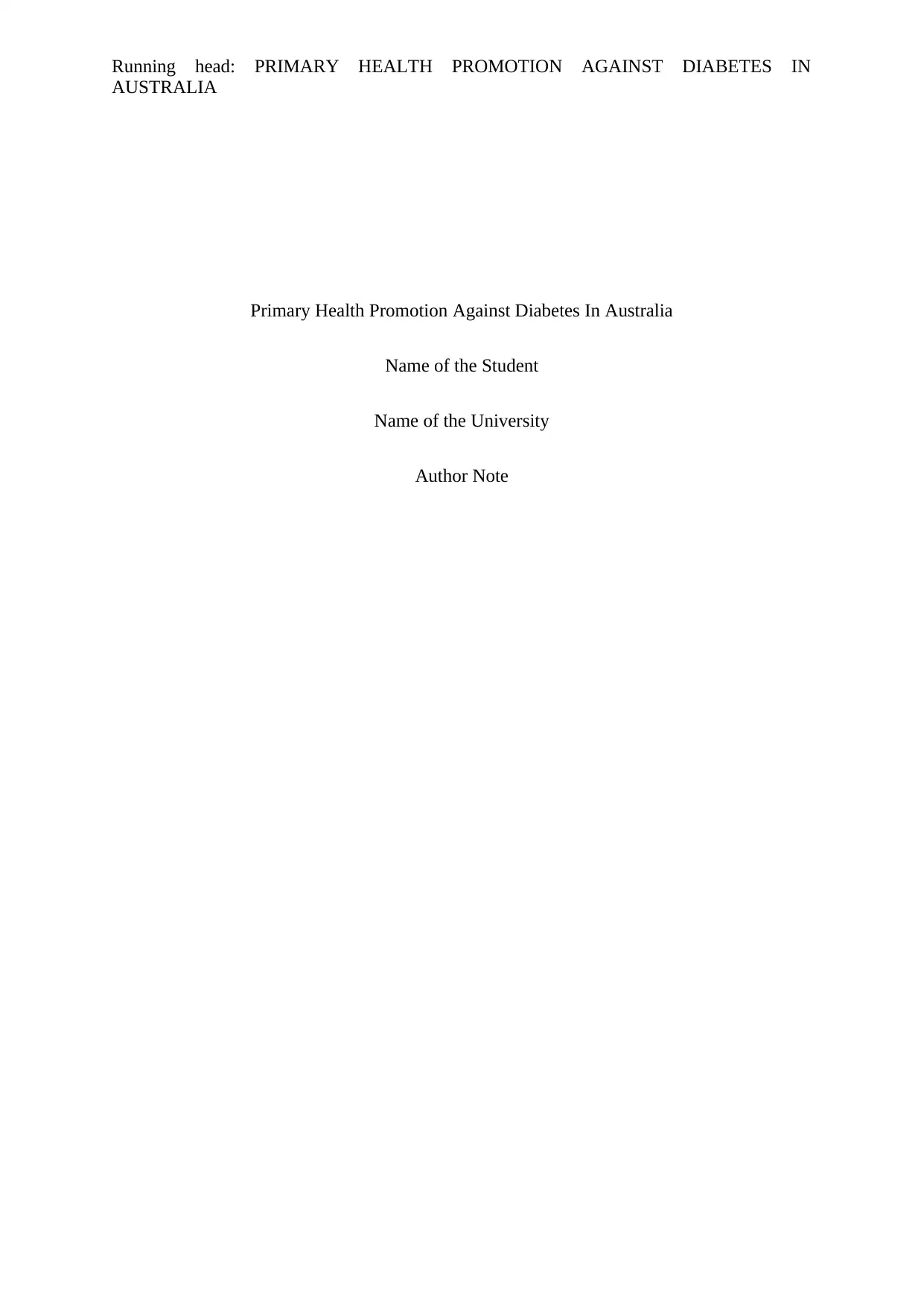
Running head: PRIMARY HEALTH PROMOTION AGAINST DIABETES IN
AUSTRALIA
Primary Health Promotion Against Diabetes In Australia
Name of the Student
Name of the University
Author Note
AUSTRALIA
Primary Health Promotion Against Diabetes In Australia
Name of the Student
Name of the University
Author Note
Paraphrase This Document
Need a fresh take? Get an instant paraphrase of this document with our AI Paraphraser
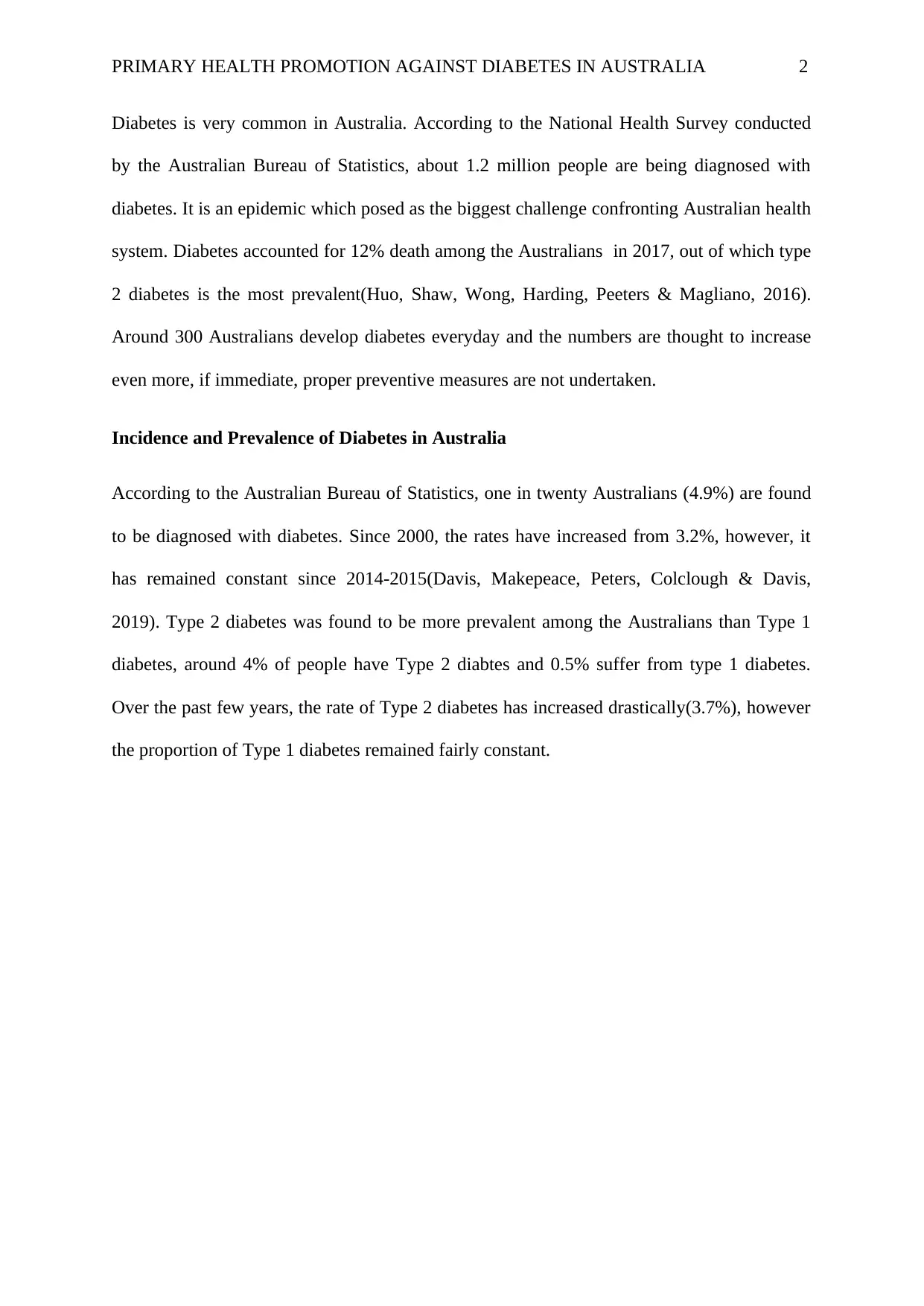
PRIMARY HEALTH PROMOTION AGAINST DIABETES IN AUSTRALIA 2
Diabetes is very common in Australia. According to the National Health Survey conducted
by the Australian Bureau of Statistics, about 1.2 million people are being diagnosed with
diabetes. It is an epidemic which posed as the biggest challenge confronting Australian health
system. Diabetes accounted for 12% death among the Australians in 2017, out of which type
2 diabetes is the most prevalent(Huo, Shaw, Wong, Harding, Peeters & Magliano, 2016).
Around 300 Australians develop diabetes everyday and the numbers are thought to increase
even more, if immediate, proper preventive measures are not undertaken.
Incidence and Prevalence of Diabetes in Australia
According to the Australian Bureau of Statistics, one in twenty Australians (4.9%) are found
to be diagnosed with diabetes. Since 2000, the rates have increased from 3.2%, however, it
has remained constant since 2014-2015(Davis, Makepeace, Peters, Colclough & Davis,
2019). Type 2 diabetes was found to be more prevalent among the Australians than Type 1
diabetes, around 4% of people have Type 2 diabtes and 0.5% suffer from type 1 diabetes.
Over the past few years, the rate of Type 2 diabetes has increased drastically(3.7%), however
the proportion of Type 1 diabetes remained fairly constant.
Diabetes is very common in Australia. According to the National Health Survey conducted
by the Australian Bureau of Statistics, about 1.2 million people are being diagnosed with
diabetes. It is an epidemic which posed as the biggest challenge confronting Australian health
system. Diabetes accounted for 12% death among the Australians in 2017, out of which type
2 diabetes is the most prevalent(Huo, Shaw, Wong, Harding, Peeters & Magliano, 2016).
Around 300 Australians develop diabetes everyday and the numbers are thought to increase
even more, if immediate, proper preventive measures are not undertaken.
Incidence and Prevalence of Diabetes in Australia
According to the Australian Bureau of Statistics, one in twenty Australians (4.9%) are found
to be diagnosed with diabetes. Since 2000, the rates have increased from 3.2%, however, it
has remained constant since 2014-2015(Davis, Makepeace, Peters, Colclough & Davis,
2019). Type 2 diabetes was found to be more prevalent among the Australians than Type 1
diabetes, around 4% of people have Type 2 diabtes and 0.5% suffer from type 1 diabetes.
Over the past few years, the rate of Type 2 diabetes has increased drastically(3.7%), however
the proportion of Type 1 diabetes remained fairly constant.
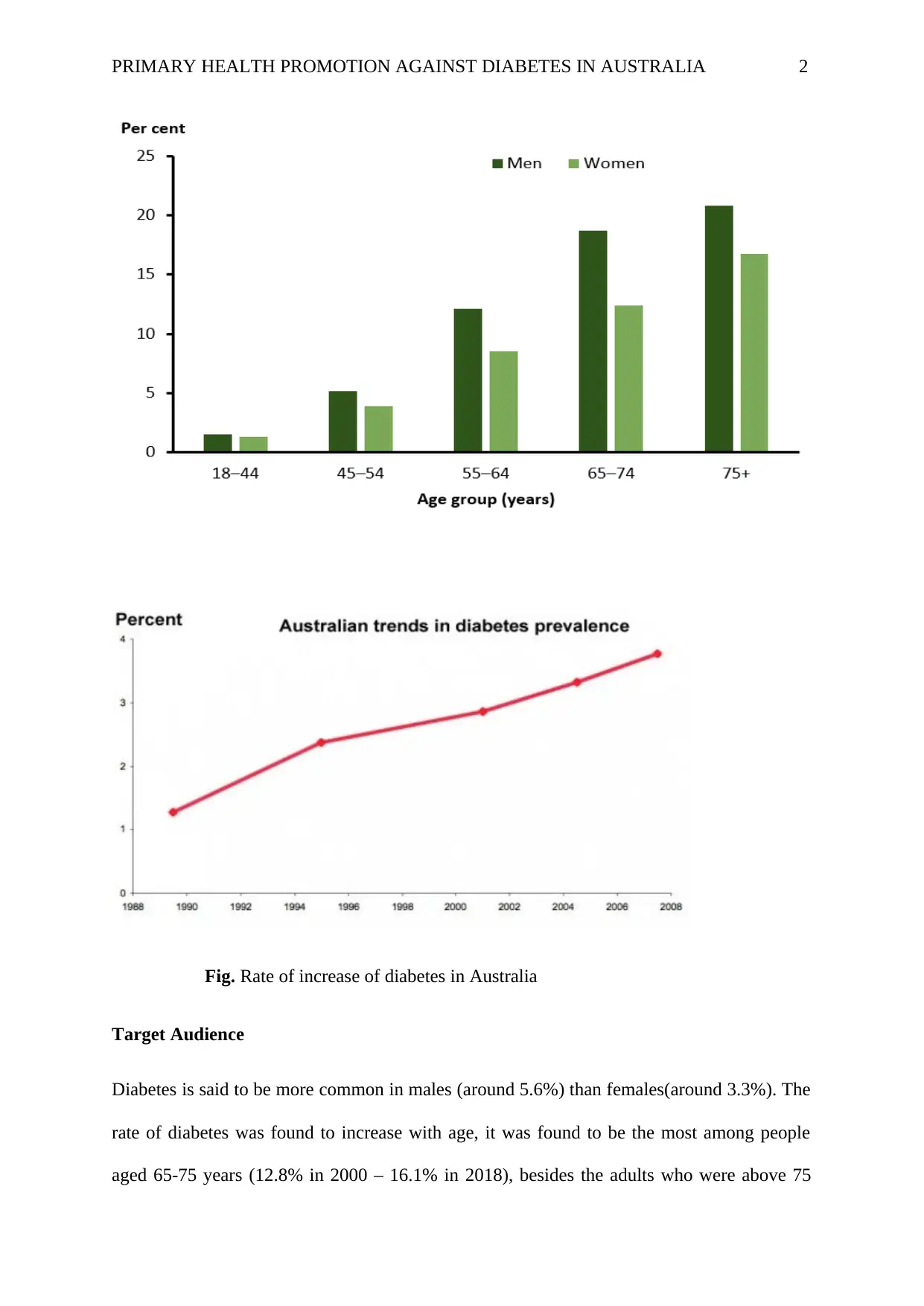
PRIMARY HEALTH PROMOTION AGAINST DIABETES IN AUSTRALIA 2
Fig. Rate of increase of diabetes in Australia
Target Audience
Diabetes is said to be more common in males (around 5.6%) than females(around 3.3%). The
rate of diabetes was found to increase with age, it was found to be the most among people
aged 65-75 years (12.8% in 2000 – 16.1% in 2018), besides the adults who were above 75
Fig. Rate of increase of diabetes in Australia
Target Audience
Diabetes is said to be more common in males (around 5.6%) than females(around 3.3%). The
rate of diabetes was found to increase with age, it was found to be the most among people
aged 65-75 years (12.8% in 2000 – 16.1% in 2018), besides the adults who were above 75
⊘ This is a preview!⊘
Do you want full access?
Subscribe today to unlock all pages.

Trusted by 1+ million students worldwide
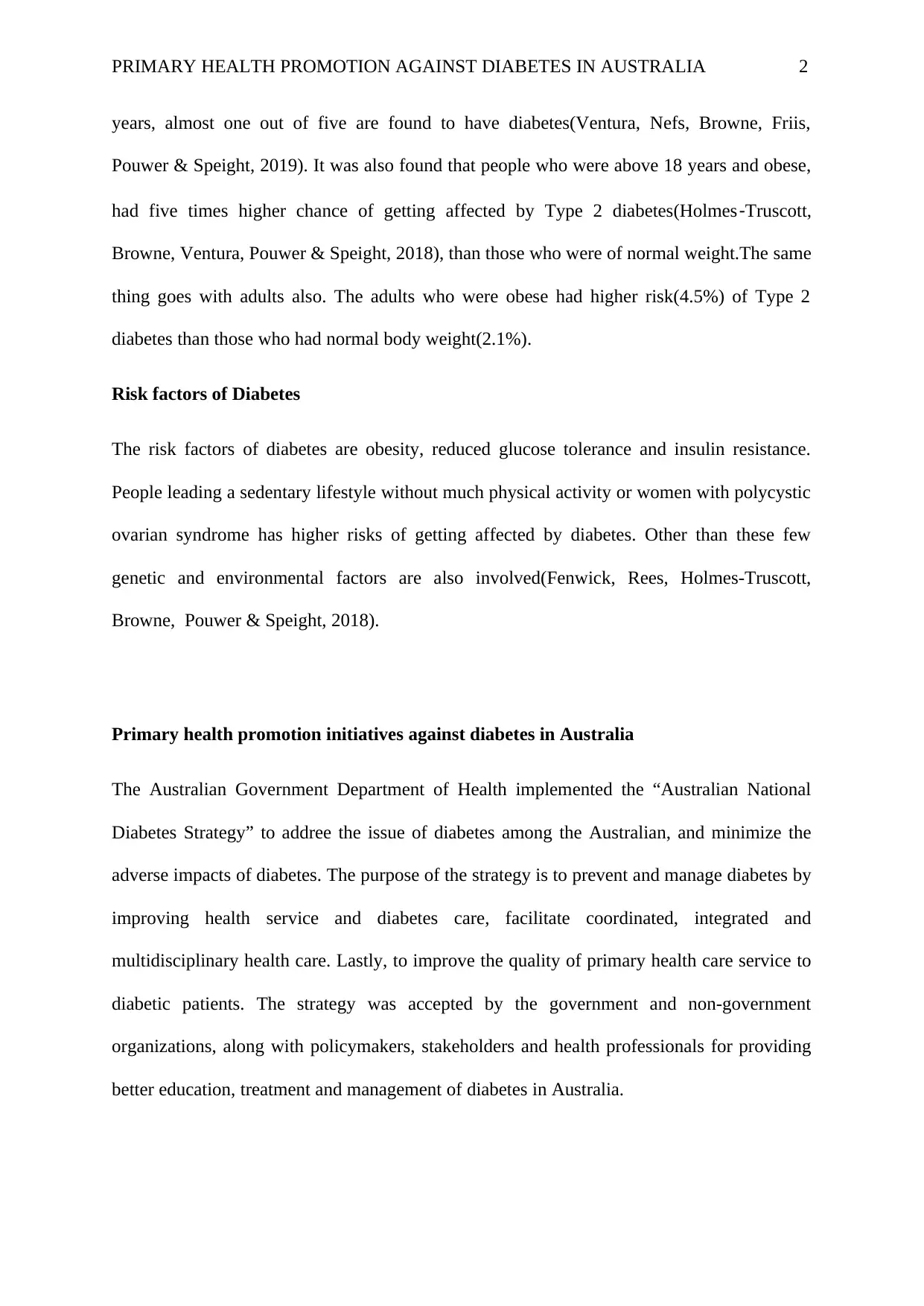
PRIMARY HEALTH PROMOTION AGAINST DIABETES IN AUSTRALIA 2
years, almost one out of five are found to have diabetes(Ventura, Nefs, Browne, Friis,
Pouwer & Speight, 2019). It was also found that people who were above 18 years and obese,
had five times higher chance of getting affected by Type 2 diabetes(Holmes‐Truscott,
Browne, Ventura, Pouwer & Speight, 2018), than those who were of normal weight.The same
thing goes with adults also. The adults who were obese had higher risk(4.5%) of Type 2
diabetes than those who had normal body weight(2.1%).
Risk factors of Diabetes
The risk factors of diabetes are obesity, reduced glucose tolerance and insulin resistance.
People leading a sedentary lifestyle without much physical activity or women with polycystic
ovarian syndrome has higher risks of getting affected by diabetes. Other than these few
genetic and environmental factors are also involved(Fenwick, Rees, Holmes-Truscott,
Browne, Pouwer & Speight, 2018).
Primary health promotion initiatives against diabetes in Australia
The Australian Government Department of Health implemented the “Australian National
Diabetes Strategy” to addree the issue of diabetes among the Australian, and minimize the
adverse impacts of diabetes. The purpose of the strategy is to prevent and manage diabetes by
improving health service and diabetes care, facilitate coordinated, integrated and
multidisciplinary health care. Lastly, to improve the quality of primary health care service to
diabetic patients. The strategy was accepted by the government and non-government
organizations, along with policymakers, stakeholders and health professionals for providing
better education, treatment and management of diabetes in Australia.
years, almost one out of five are found to have diabetes(Ventura, Nefs, Browne, Friis,
Pouwer & Speight, 2019). It was also found that people who were above 18 years and obese,
had five times higher chance of getting affected by Type 2 diabetes(Holmes‐Truscott,
Browne, Ventura, Pouwer & Speight, 2018), than those who were of normal weight.The same
thing goes with adults also. The adults who were obese had higher risk(4.5%) of Type 2
diabetes than those who had normal body weight(2.1%).
Risk factors of Diabetes
The risk factors of diabetes are obesity, reduced glucose tolerance and insulin resistance.
People leading a sedentary lifestyle without much physical activity or women with polycystic
ovarian syndrome has higher risks of getting affected by diabetes. Other than these few
genetic and environmental factors are also involved(Fenwick, Rees, Holmes-Truscott,
Browne, Pouwer & Speight, 2018).
Primary health promotion initiatives against diabetes in Australia
The Australian Government Department of Health implemented the “Australian National
Diabetes Strategy” to addree the issue of diabetes among the Australian, and minimize the
adverse impacts of diabetes. The purpose of the strategy is to prevent and manage diabetes by
improving health service and diabetes care, facilitate coordinated, integrated and
multidisciplinary health care. Lastly, to improve the quality of primary health care service to
diabetic patients. The strategy was accepted by the government and non-government
organizations, along with policymakers, stakeholders and health professionals for providing
better education, treatment and management of diabetes in Australia.
Paraphrase This Document
Need a fresh take? Get an instant paraphrase of this document with our AI Paraphraser
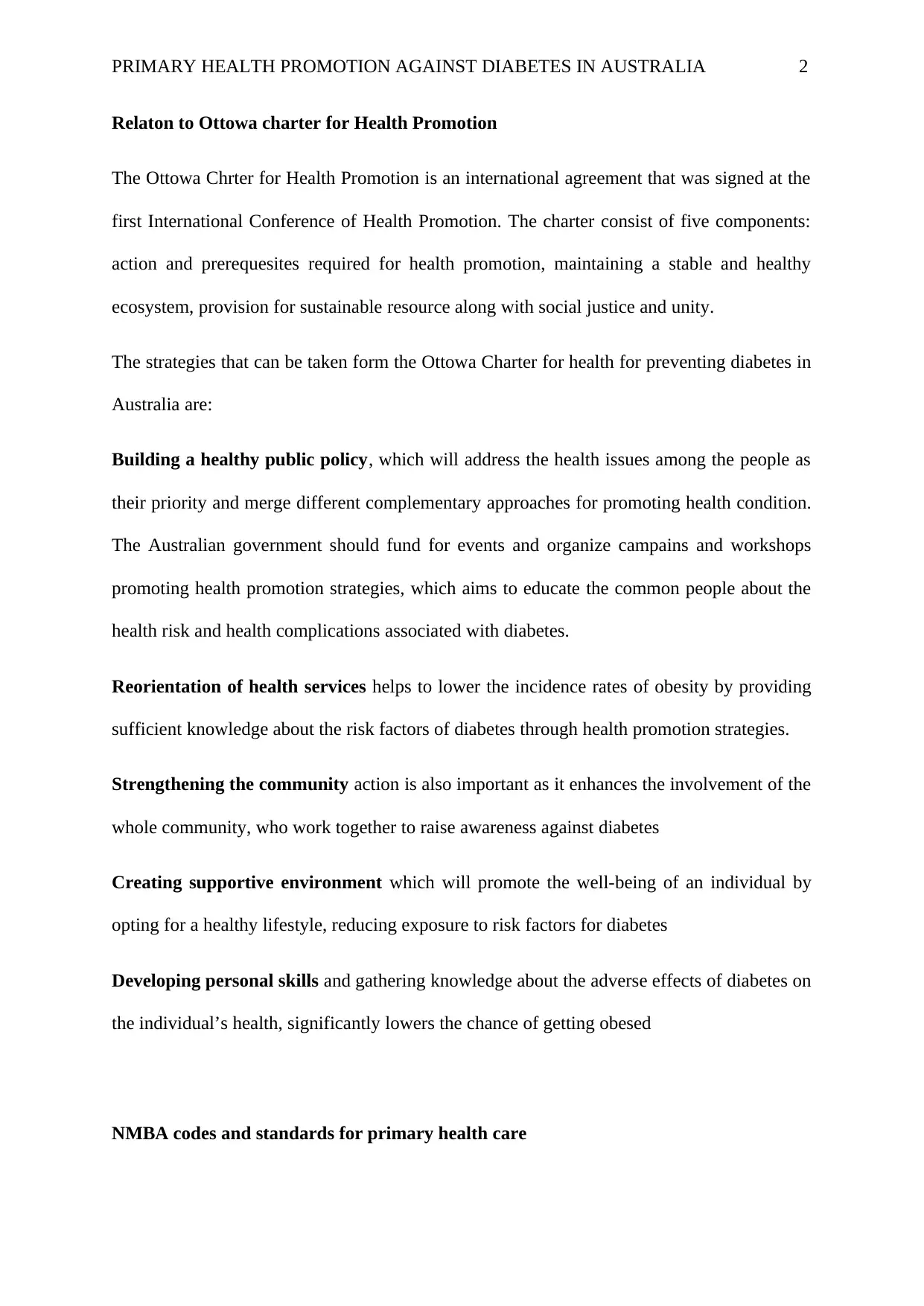
PRIMARY HEALTH PROMOTION AGAINST DIABETES IN AUSTRALIA 2
Relaton to Ottowa charter for Health Promotion
The Ottowa Chrter for Health Promotion is an international agreement that was signed at the
first International Conference of Health Promotion. The charter consist of five components:
action and prerequesites required for health promotion, maintaining a stable and healthy
ecosystem, provision for sustainable resource along with social justice and unity.
The strategies that can be taken form the Ottowa Charter for health for preventing diabetes in
Australia are:
Building a healthy public policy, which will address the health issues among the people as
their priority and merge different complementary approaches for promoting health condition.
The Australian government should fund for events and organize campains and workshops
promoting health promotion strategies, which aims to educate the common people about the
health risk and health complications associated with diabetes.
Reorientation of health services helps to lower the incidence rates of obesity by providing
sufficient knowledge about the risk factors of diabetes through health promotion strategies.
Strengthening the community action is also important as it enhances the involvement of the
whole community, who work together to raise awareness against diabetes
Creating supportive environment which will promote the well-being of an individual by
opting for a healthy lifestyle, reducing exposure to risk factors for diabetes
Developing personal skills and gathering knowledge about the adverse effects of diabetes on
the individual’s health, significantly lowers the chance of getting obesed
NMBA codes and standards for primary health care
Relaton to Ottowa charter for Health Promotion
The Ottowa Chrter for Health Promotion is an international agreement that was signed at the
first International Conference of Health Promotion. The charter consist of five components:
action and prerequesites required for health promotion, maintaining a stable and healthy
ecosystem, provision for sustainable resource along with social justice and unity.
The strategies that can be taken form the Ottowa Charter for health for preventing diabetes in
Australia are:
Building a healthy public policy, which will address the health issues among the people as
their priority and merge different complementary approaches for promoting health condition.
The Australian government should fund for events and organize campains and workshops
promoting health promotion strategies, which aims to educate the common people about the
health risk and health complications associated with diabetes.
Reorientation of health services helps to lower the incidence rates of obesity by providing
sufficient knowledge about the risk factors of diabetes through health promotion strategies.
Strengthening the community action is also important as it enhances the involvement of the
whole community, who work together to raise awareness against diabetes
Creating supportive environment which will promote the well-being of an individual by
opting for a healthy lifestyle, reducing exposure to risk factors for diabetes
Developing personal skills and gathering knowledge about the adverse effects of diabetes on
the individual’s health, significantly lowers the chance of getting obesed
NMBA codes and standards for primary health care
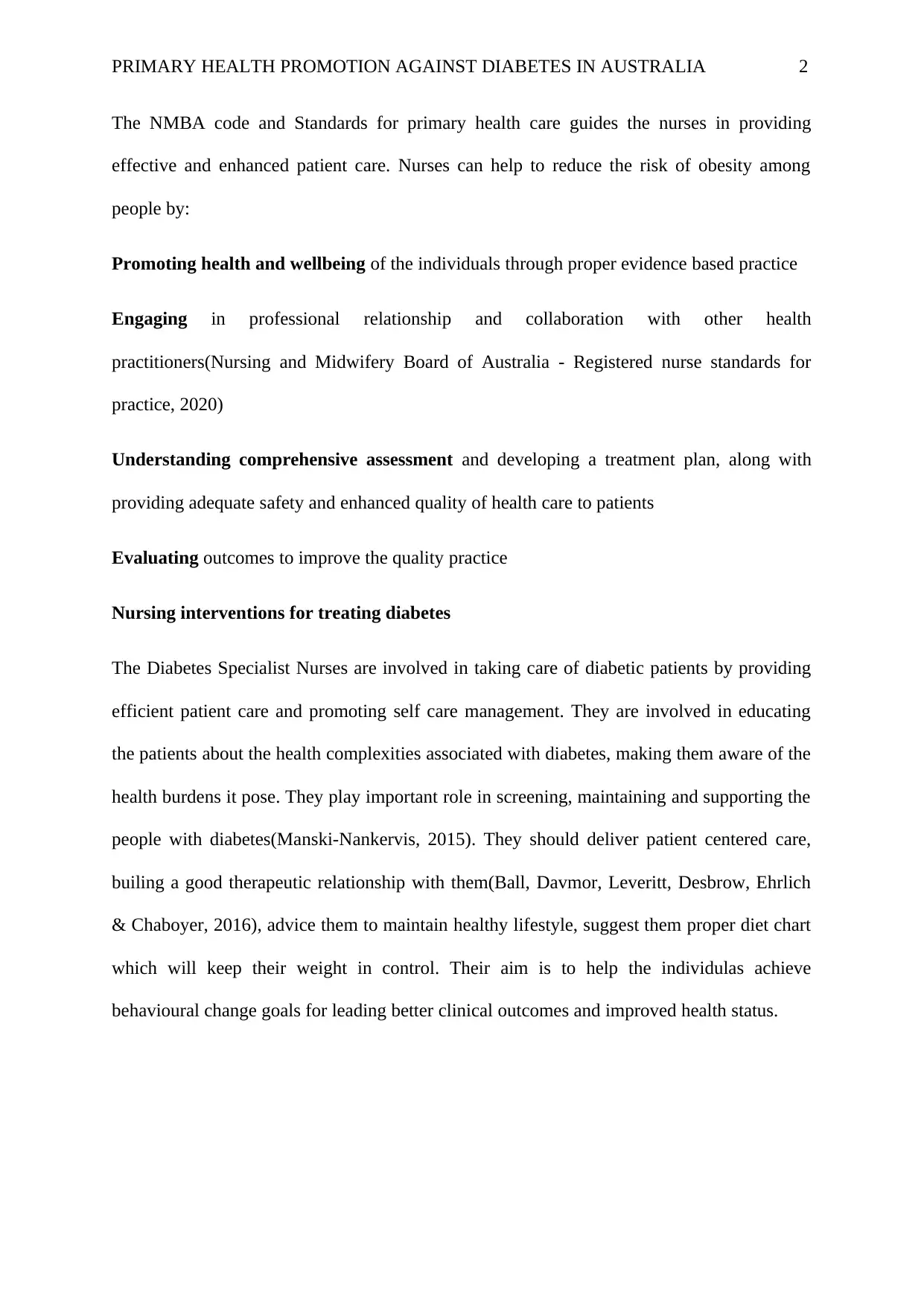
PRIMARY HEALTH PROMOTION AGAINST DIABETES IN AUSTRALIA 2
The NMBA code and Standards for primary health care guides the nurses in providing
effective and enhanced patient care. Nurses can help to reduce the risk of obesity among
people by:
Promoting health and wellbeing of the individuals through proper evidence based practice
Engaging in professional relationship and collaboration with other health
practitioners(Nursing and Midwifery Board of Australia - Registered nurse standards for
practice, 2020)
Understanding comprehensive assessment and developing a treatment plan, along with
providing adequate safety and enhanced quality of health care to patients
Evaluating outcomes to improve the quality practice
Nursing interventions for treating diabetes
The Diabetes Specialist Nurses are involved in taking care of diabetic patients by providing
efficient patient care and promoting self care management. They are involved in educating
the patients about the health complexities associated with diabetes, making them aware of the
health burdens it pose. They play important role in screening, maintaining and supporting the
people with diabetes(Manski-Nankervis, 2015). They should deliver patient centered care,
builing a good therapeutic relationship with them(Ball, Davmor, Leveritt, Desbrow, Ehrlich
& Chaboyer, 2016), advice them to maintain healthy lifestyle, suggest them proper diet chart
which will keep their weight in control. Their aim is to help the individulas achieve
behavioural change goals for leading better clinical outcomes and improved health status.
The NMBA code and Standards for primary health care guides the nurses in providing
effective and enhanced patient care. Nurses can help to reduce the risk of obesity among
people by:
Promoting health and wellbeing of the individuals through proper evidence based practice
Engaging in professional relationship and collaboration with other health
practitioners(Nursing and Midwifery Board of Australia - Registered nurse standards for
practice, 2020)
Understanding comprehensive assessment and developing a treatment plan, along with
providing adequate safety and enhanced quality of health care to patients
Evaluating outcomes to improve the quality practice
Nursing interventions for treating diabetes
The Diabetes Specialist Nurses are involved in taking care of diabetic patients by providing
efficient patient care and promoting self care management. They are involved in educating
the patients about the health complexities associated with diabetes, making them aware of the
health burdens it pose. They play important role in screening, maintaining and supporting the
people with diabetes(Manski-Nankervis, 2015). They should deliver patient centered care,
builing a good therapeutic relationship with them(Ball, Davmor, Leveritt, Desbrow, Ehrlich
& Chaboyer, 2016), advice them to maintain healthy lifestyle, suggest them proper diet chart
which will keep their weight in control. Their aim is to help the individulas achieve
behavioural change goals for leading better clinical outcomes and improved health status.
⊘ This is a preview!⊘
Do you want full access?
Subscribe today to unlock all pages.

Trusted by 1+ million students worldwide
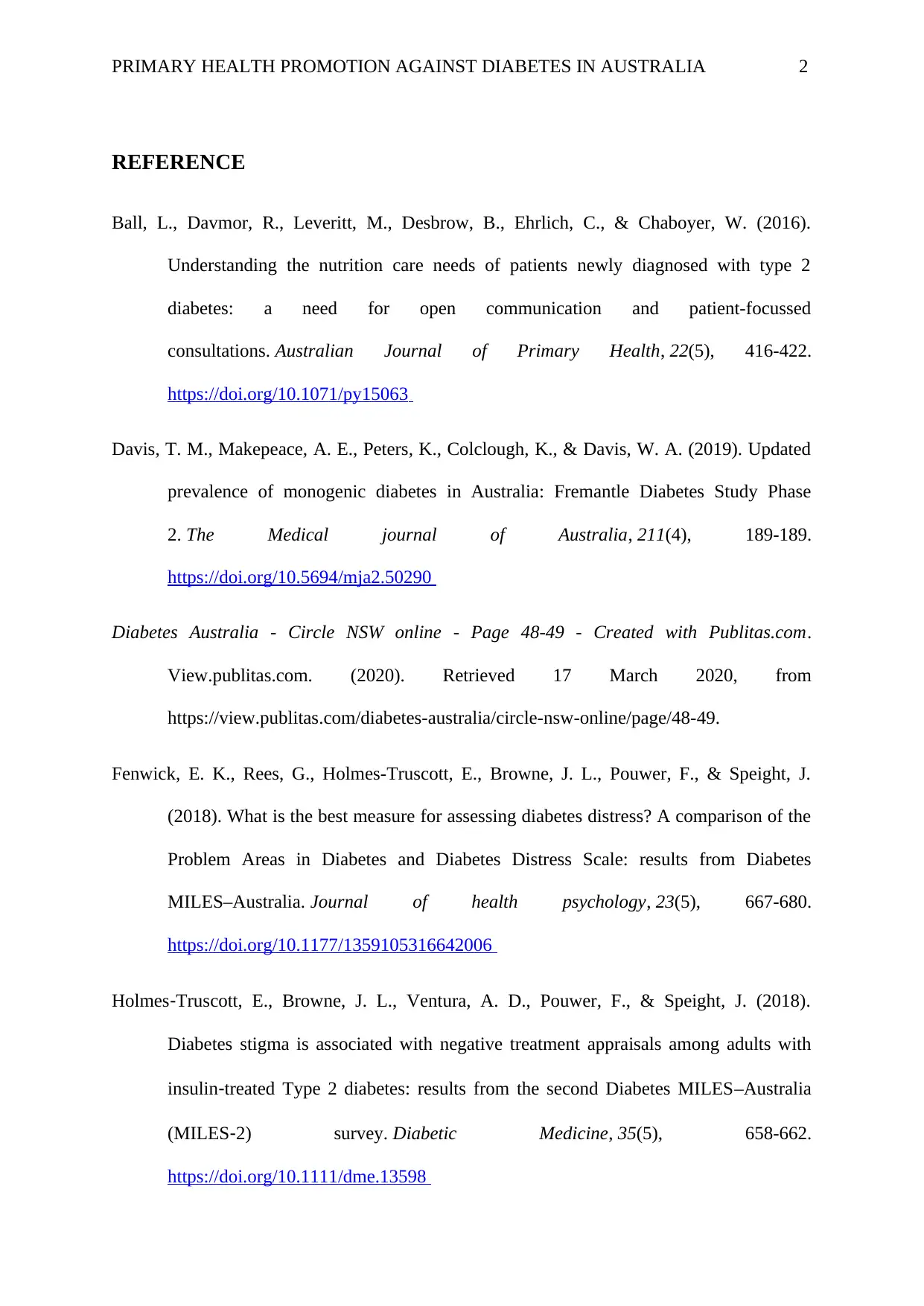
PRIMARY HEALTH PROMOTION AGAINST DIABETES IN AUSTRALIA 2
REFERENCE
Ball, L., Davmor, R., Leveritt, M., Desbrow, B., Ehrlich, C., & Chaboyer, W. (2016).
Understanding the nutrition care needs of patients newly diagnosed with type 2
diabetes: a need for open communication and patient-focussed
consultations. Australian Journal of Primary Health, 22(5), 416-422.
https://doi.org/10.1071/py15063
Davis, T. M., Makepeace, A. E., Peters, K., Colclough, K., & Davis, W. A. (2019). Updated
prevalence of monogenic diabetes in Australia: Fremantle Diabetes Study Phase
2. The Medical journal of Australia, 211(4), 189-189.
https://doi.org/10.5694/mja2.50290
Diabetes Australia - Circle NSW online - Page 48-49 - Created with Publitas.com.
View.publitas.com. (2020). Retrieved 17 March 2020, from
https://view.publitas.com/diabetes-australia/circle-nsw-online/page/48-49.
Fenwick, E. K., Rees, G., Holmes-Truscott, E., Browne, J. L., Pouwer, F., & Speight, J.
(2018). What is the best measure for assessing diabetes distress? A comparison of the
Problem Areas in Diabetes and Diabetes Distress Scale: results from Diabetes
MILES–Australia. Journal of health psychology, 23(5), 667-680.
https://doi.org/10.1177/1359105316642006
Holmes‐Truscott, E., Browne, J. L., Ventura, A. D., Pouwer, F., & Speight, J. (2018).
Diabetes stigma is associated with negative treatment appraisals among adults with
insulin‐treated Type 2 diabetes: results from the second Diabetes MILES–Australia
(MILES‐2) survey. Diabetic Medicine, 35(5), 658-662.
https://doi.org/10.1111/dme.13598
REFERENCE
Ball, L., Davmor, R., Leveritt, M., Desbrow, B., Ehrlich, C., & Chaboyer, W. (2016).
Understanding the nutrition care needs of patients newly diagnosed with type 2
diabetes: a need for open communication and patient-focussed
consultations. Australian Journal of Primary Health, 22(5), 416-422.
https://doi.org/10.1071/py15063
Davis, T. M., Makepeace, A. E., Peters, K., Colclough, K., & Davis, W. A. (2019). Updated
prevalence of monogenic diabetes in Australia: Fremantle Diabetes Study Phase
2. The Medical journal of Australia, 211(4), 189-189.
https://doi.org/10.5694/mja2.50290
Diabetes Australia - Circle NSW online - Page 48-49 - Created with Publitas.com.
View.publitas.com. (2020). Retrieved 17 March 2020, from
https://view.publitas.com/diabetes-australia/circle-nsw-online/page/48-49.
Fenwick, E. K., Rees, G., Holmes-Truscott, E., Browne, J. L., Pouwer, F., & Speight, J.
(2018). What is the best measure for assessing diabetes distress? A comparison of the
Problem Areas in Diabetes and Diabetes Distress Scale: results from Diabetes
MILES–Australia. Journal of health psychology, 23(5), 667-680.
https://doi.org/10.1177/1359105316642006
Holmes‐Truscott, E., Browne, J. L., Ventura, A. D., Pouwer, F., & Speight, J. (2018).
Diabetes stigma is associated with negative treatment appraisals among adults with
insulin‐treated Type 2 diabetes: results from the second Diabetes MILES–Australia
(MILES‐2) survey. Diabetic Medicine, 35(5), 658-662.
https://doi.org/10.1111/dme.13598
Paraphrase This Document
Need a fresh take? Get an instant paraphrase of this document with our AI Paraphraser
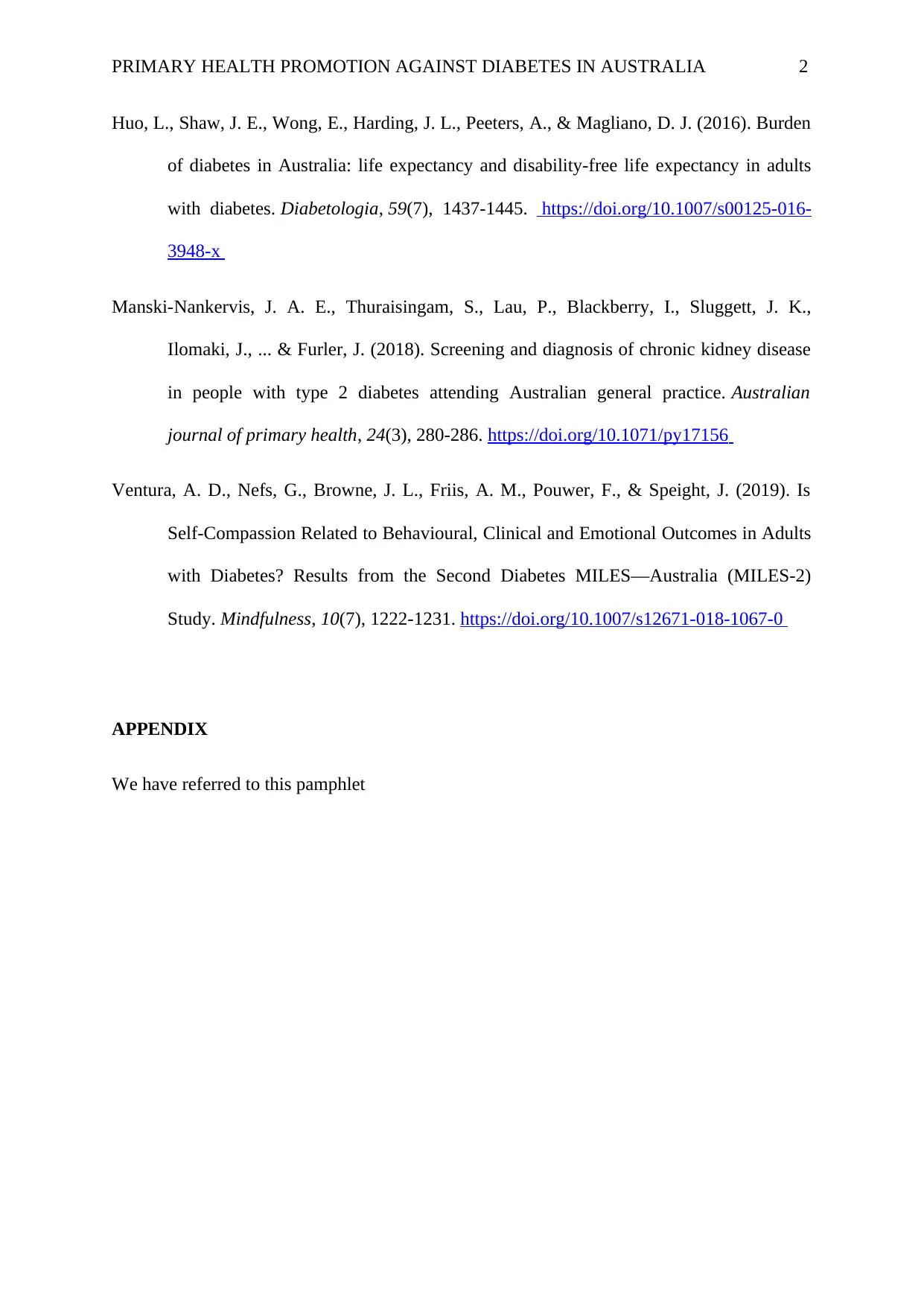
PRIMARY HEALTH PROMOTION AGAINST DIABETES IN AUSTRALIA 2
Huo, L., Shaw, J. E., Wong, E., Harding, J. L., Peeters, A., & Magliano, D. J. (2016). Burden
of diabetes in Australia: life expectancy and disability-free life expectancy in adults
with diabetes. Diabetologia, 59(7), 1437-1445. https://doi.org/10.1007/s00125-016-
3948-x
Manski-Nankervis, J. A. E., Thuraisingam, S., Lau, P., Blackberry, I., Sluggett, J. K.,
Ilomaki, J., ... & Furler, J. (2018). Screening and diagnosis of chronic kidney disease
in people with type 2 diabetes attending Australian general practice. Australian
journal of primary health, 24(3), 280-286. https://doi.org/10.1071/py17156
Ventura, A. D., Nefs, G., Browne, J. L., Friis, A. M., Pouwer, F., & Speight, J. (2019). Is
Self-Compassion Related to Behavioural, Clinical and Emotional Outcomes in Adults
with Diabetes? Results from the Second Diabetes MILES—Australia (MILES-2)
Study. Mindfulness, 10(7), 1222-1231. https://doi.org/10.1007/s12671-018-1067-0
APPENDIX
We have referred to this pamphlet
Huo, L., Shaw, J. E., Wong, E., Harding, J. L., Peeters, A., & Magliano, D. J. (2016). Burden
of diabetes in Australia: life expectancy and disability-free life expectancy in adults
with diabetes. Diabetologia, 59(7), 1437-1445. https://doi.org/10.1007/s00125-016-
3948-x
Manski-Nankervis, J. A. E., Thuraisingam, S., Lau, P., Blackberry, I., Sluggett, J. K.,
Ilomaki, J., ... & Furler, J. (2018). Screening and diagnosis of chronic kidney disease
in people with type 2 diabetes attending Australian general practice. Australian
journal of primary health, 24(3), 280-286. https://doi.org/10.1071/py17156
Ventura, A. D., Nefs, G., Browne, J. L., Friis, A. M., Pouwer, F., & Speight, J. (2019). Is
Self-Compassion Related to Behavioural, Clinical and Emotional Outcomes in Adults
with Diabetes? Results from the Second Diabetes MILES—Australia (MILES-2)
Study. Mindfulness, 10(7), 1222-1231. https://doi.org/10.1007/s12671-018-1067-0
APPENDIX
We have referred to this pamphlet
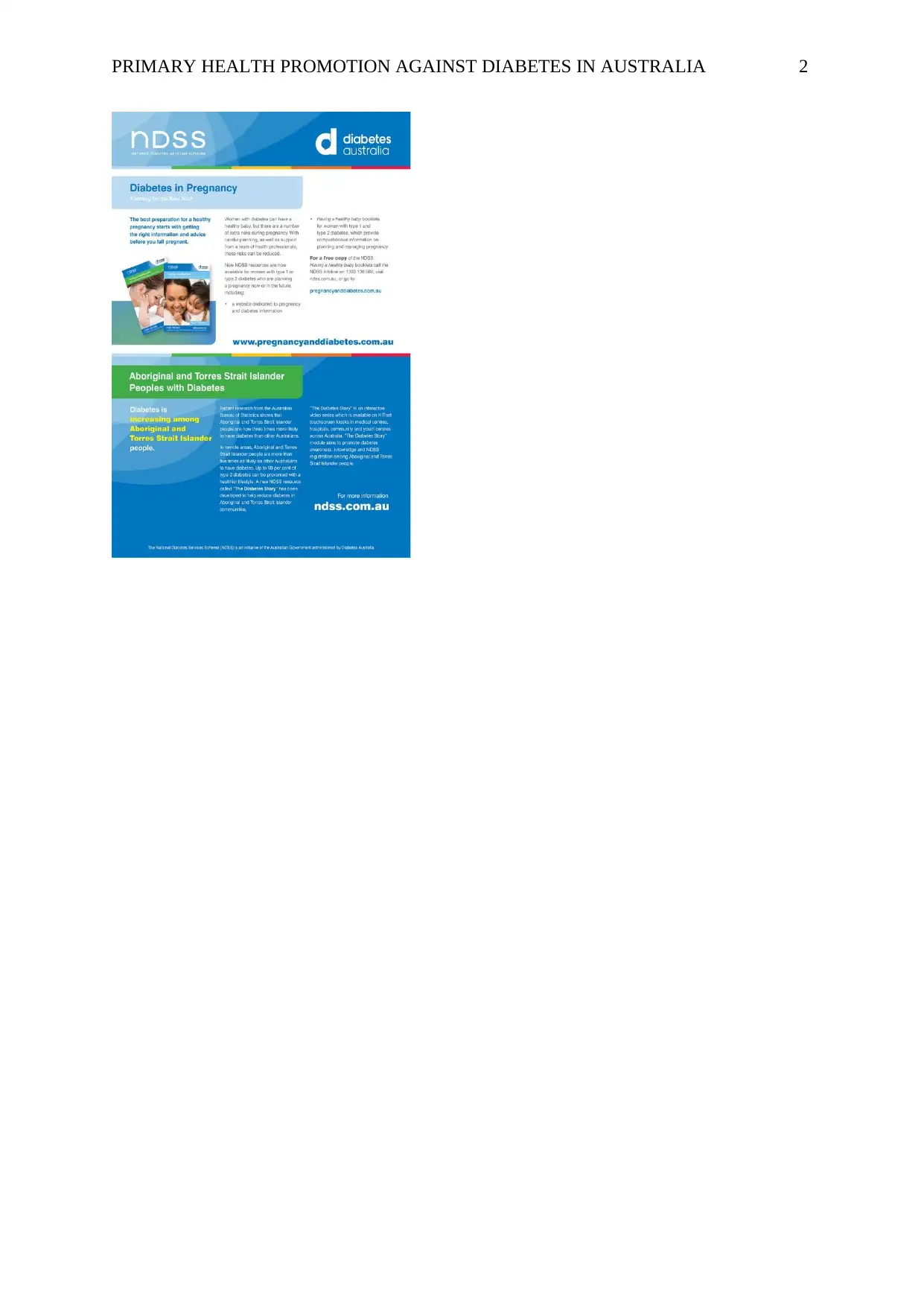
PRIMARY HEALTH PROMOTION AGAINST DIABETES IN AUSTRALIA 2
⊘ This is a preview!⊘
Do you want full access?
Subscribe today to unlock all pages.

Trusted by 1+ million students worldwide
1 out of 9
Related Documents
Your All-in-One AI-Powered Toolkit for Academic Success.
+13062052269
info@desklib.com
Available 24*7 on WhatsApp / Email
![[object Object]](/_next/static/media/star-bottom.7253800d.svg)
Unlock your academic potential
Copyright © 2020–2025 A2Z Services. All Rights Reserved. Developed and managed by ZUCOL.





